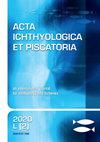Small-scale fisheries in the southern Black Sea: Which factors affect net profit?
IF 0.8
4区 农林科学
Q3 FISHERIES
引用次数: 2
Abstract
Small-scale fisheries (SSF) is a local and community-based activity that can be traced back to ancient times, and thus, closely related to the history of humankind. However, large-scale fisheries have grown tremendously, approaching an industrial sector in the last century, due to their socio-economic and political properties, including both national and international aspects. This progress towards industrial-scale fisheries led to the involvement of scientific research, first aiming to improve production efficiency, and then, to protect ecosystems as resources exploited for fisheries activity, by mitigating their adverse impacts. During this evolutionary progress, SSF was usually neglected because of their limited production ability, and thus minimal economic contribution, until the later phase when the protection of ecosystem resources gained sufficient importance. As a result of this, many countries lack data on SSF, undermining efforts for the creation of proper policies for this type of fisheries. The aim of this study was to evaluate the productivity and the effects of some demographic characteristics, boat structures, and some cost (input) items on the net profit of SSF in the Black Sea. The eligible sample for this study consisted of 5575 small-scale fishing boats in the Black Sea. The number of fishers to be surveyed was determined as 315 using the “Simple Random Sampling” method, based on operators of boats < 12 m, i.e., boats in the SSF. Questionnaires were conducted face-to-face with fishers. In this study, it was tested if six parameters were investigated to determine whether they had a significant effect on net profit in SSF. These parameters were: (1) engine power; (2) number of fishing days; (3) boat length; (4) consumption of fuel in fishing; (5) education level of fishers; and (6) overall professional experience of fishers. To do so, Simple Linear Regression Analysis was performed to determine the effect of the data considered as independent variables when the net profit was set as the dependent variable. Atlantic bonito, Sarda sarda (Bloch, 1793); whiting, Merlangius merlangus (Linnaeus, 1758); rapa whelk, Rapana venosa (Valenciennes, 1846); and turbot, Scophthalmus maximus (Linnaeus, 1758) were the most important commercial fish species for small scale fishing. When catch per boat in SSF was evaluated, Kırklareli province ranked first with 97 007 kg, with Atlantic bonito (44 778 kg) being the most common species caught. Samsun had the second-largest catch per boat with 91 761 kg. The total net profit of 303 boats was calculated as €1 794 938 and the mean net profit per boat was €5924. The highest per boat mean net profit (€25 909) was in Kırklareli. According to the results of the study, the number of days at the sea, boat length, engine power, and fuel cost had a significant effect on the net profit while education level and professional experience were not important in productivity. The economically-fragile SSF sector may need some kind of supporting subsidy. It would be beneficial to provide support to the majority of fishers active in the SSF in terms of complementary alternative employment opportunities in the regions where they are located.黑海南部的小规模渔业:哪些因素影响净利润?
小规模渔业是一项可以追溯到古代的地方和社区活动,因此与人类历史密切相关。然而,由于其社会经济和政治特性,包括国家和国际方面的特性,大型渔业在上个世纪已经大幅增长,接近工业部门。工业规模渔业的这一进展导致了科学研究的参与,首先旨在提高生产效率,然后通过减轻生态系统的不利影响来保护作为渔业活动资源的生态系统。在这一进化过程中,SSF通常被忽视,因为它们的生产能力有限,因此经济贡献很小,直到后期保护生态系统资源变得足够重要。因此,许多国家缺乏关于SSF的数据,破坏了为这类渔业制定适当政策的努力。本研究的目的是评估生产力以及一些人口特征、船只结构和一些成本(投入)项目对黑海SSF净利润的影响。这项研究的合格样本包括黑海的5575艘小型渔船。使用“简单随机抽样”方法,根据<12m的渔船(即SSF中的渔船)的操作员,确定待调查的渔民人数为315人。问卷调查是与渔民面对面进行的。在这项研究中,测试了是否调查了六个参数,以确定它们是否对SSF的净利润有显著影响。这些参数是:(1)发动机功率;(2) 捕鱼天数;(3) 船长;(4) 捕鱼燃料消耗;(5) 渔民的教育水平;以及(6)渔民的整体专业经验。为此,进行了简单线性回归分析,以确定当净利润设置为因变量时,被视为自变量的数据的影响。大西洋鲣鱼,萨达·萨尔达(布洛赫,1793);鳕鱼,Merlangius merlangus(林奈,1758);雷帕·海螺(Rapana venosa)(Valenciennes,1846);大菱鲆(Linnaeus,1758)是小规模捕捞最重要的商业鱼类。当评估SSF中每艘船的捕获量时,Kırklareli省以97007公斤位居第一,大西洋鲣鱼(44778公斤)是最常见的捕获物种。Samsun的每艘船捕获量为91761公斤,位居第二。303艘船的总净利润为1794938欧元,每艘船的平均净利润为5924欧元。Kırklareli的每艘船平均净利润最高(25909欧元)。根据研究结果,出海天数、船长、发动机功率和燃料成本对净利润有显著影响,而教育水平和专业经验对生产力并不重要。经济脆弱的社保基金部门可能需要某种支持性补贴。为活跃在SSF的大多数渔民提供支持,在他们所在地区提供补充的替代就业机会,这将是有益的。
本文章由计算机程序翻译,如有差异,请以英文原文为准。
求助全文
约1分钟内获得全文
求助全文
来源期刊

Acta Ichthyologica Et Piscatoria
FISHERIES-ZOOLOGY
CiteScore
2.20
自引率
0.00%
发文量
31
审稿时长
>12 weeks
期刊介绍:
ACTA ICHTHYOLOGICA ET PISCATORIA (AIeP) is an international, peer-reviewed scientific journal that publishes articles based on original experimental data or experimental methods, or new analyses of already existing data, in any aspect of ichthyology and fisheries (fin-fish only).
 求助内容:
求助内容: 应助结果提醒方式:
应助结果提醒方式:


